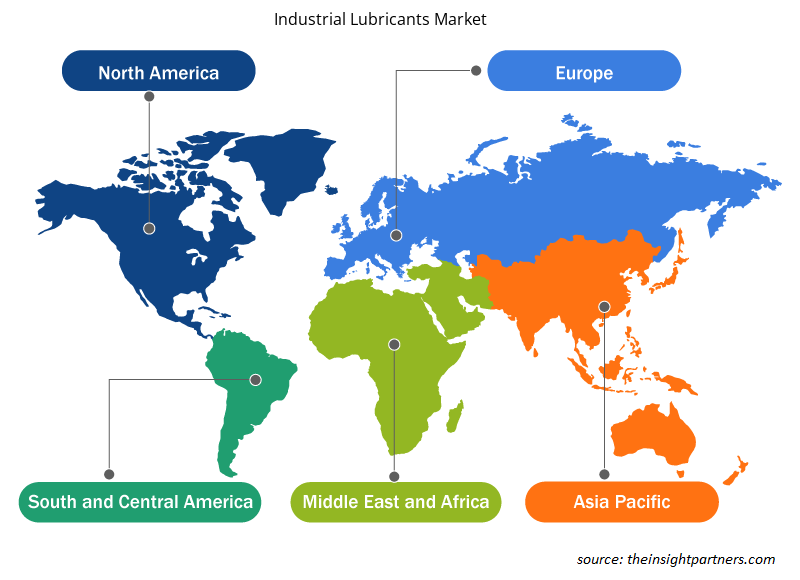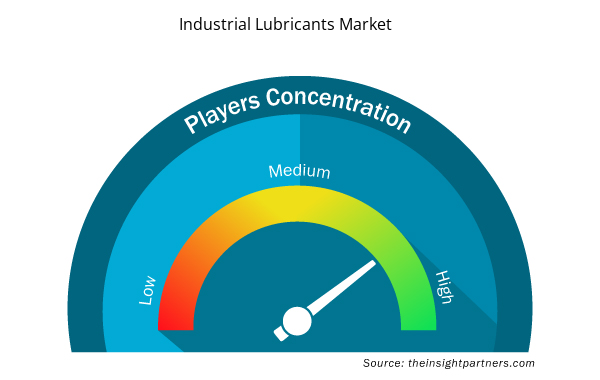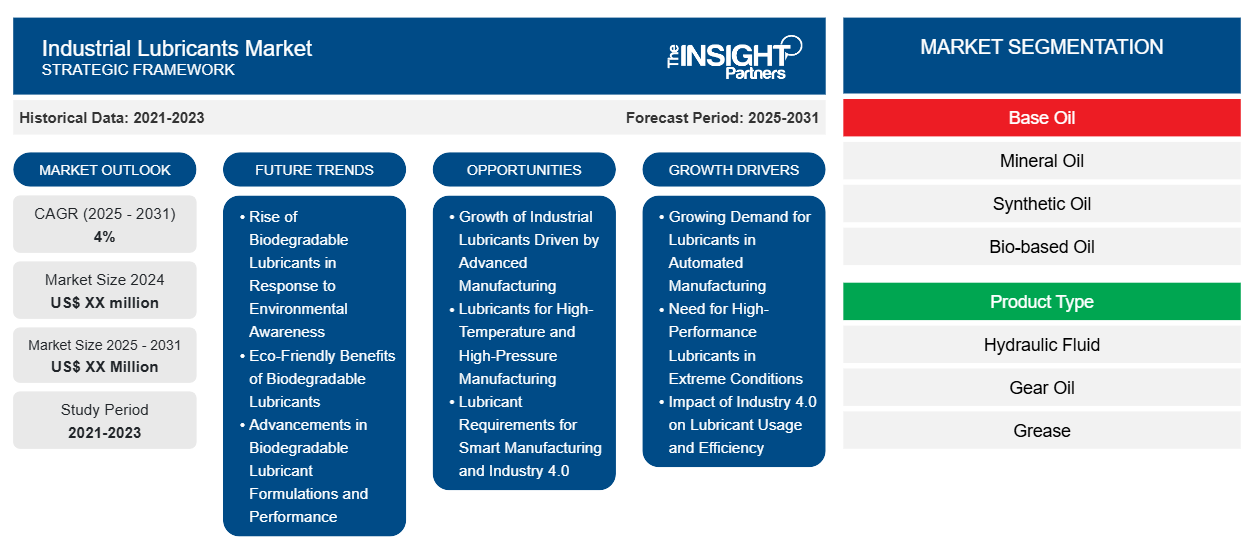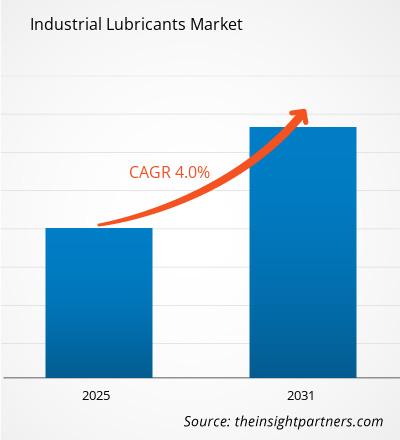من المتوقع أن يسجل سوق زيوت التشحيم الصناعية معدل نمو سنوي مركب بنسبة 4٪ من عام 2023 إلى عام 2031، مع توسع حجم السوق من XX مليون دولار أمريكي في عام 2023 إلى XX مليون دولار أمريكي بحلول عام 2031.
يقدم التقرير تحليلاً يعتمد على الزيت الأساسي (الزيت المعدني والزيت الاصطناعي والزيت الحيوي). يتم تقسيم التقرير حسب نوع المنتج (السائل الهيدروليكي وزيت التروس والشحم وزيت الضاغط وغيرها). يتم تقسيم التقرير حسب صناعة الاستخدام النهائي (السيارات والفضاء والبناء والبحرية والتعدين ومعالجة الأغذية والنفط والغاز والطب وغيرها). يتم تقسيم التحليل العالمي بشكل أكبر على المستوى الإقليمي والدول الرئيسية. يتم تغطية حجم السوق والتوقعات على المستويات العالمية والإقليمية والقطرية لجميع قطاعات السوق الرئيسية ضمن النطاق. يقدم التقرير القيمة بالدولار الأمريكي للتحليل والقطاعات المذكورة أعلاه. يقدم التقرير إحصائيات رئيسية عن حالة السوق للاعبين الرئيسيين في السوق ويعرض اتجاهات السوق والفرص.
غرض التقرير
يهدف تقرير سوق زيوت التشحيم الصناعية الصادر عن The Insight Partners إلى وصف المشهد الحالي والنمو المستقبلي وأهم العوامل الدافعة والتحديات والفرص. وسيوفر هذا رؤى لمختلف أصحاب المصلحة في الأعمال التجارية، مثل:
- مزودي/مصنعي التكنولوجيا: لفهم ديناميكيات السوق المتطورة ومعرفة فرص النمو المحتملة، وتمكينهم من اتخاذ قرارات استراتيجية مستنيرة.
- المستثمرون: إجراء تحليل شامل للاتجاهات فيما يتعلق بمعدل نمو السوق، وتوقعات السوق المالية، والفرص المتاحة عبر سلسلة القيمة.
- الهيئات التنظيمية: لتنظيم السياسات ومراقبة الأنشطة في السوق بهدف تقليل الانتهاكات والحفاظ على ثقة المستثمرين والحفاظ على سلامة السوق واستقرارها.
تجزئة سوق زيوت التشحيم الصناعية
زيت القاعدة
- زيت معدني
- زيت صناعي
- زيت حيوي
نوع المنتج
- سائل هيدروليكي
- زيت التروس
- شحم
- زيت الضاغط
صناعة الاستخدام النهائي
- السيارات
- الفضاء الجوي
- بناء
- بحري
- التعدين
- معالجة الأغذية
- النفط والغاز
- طبي
الجغرافيا
- أمريكا الشمالية
- أوروبا
- آسيا والمحيط الهادئ
- أمريكا الجنوبية والوسطى
- الشرق الأوسط وأفريقيا
الجغرافيا
- أمريكا الشمالية
- أوروبا
- آسيا والمحيط الهادئ
- أمريكا الجنوبية والوسطى
- الشرق الأوسط وأفريقيا
قم بتخصيص هذا التقرير ليناسب متطلباتك
ستحصل على تخصيص لأي تقرير - مجانًا - بما في ذلك أجزاء من هذا التقرير، أو تحليل على مستوى الدولة، وحزمة بيانات Excel، بالإضافة إلى الاستفادة من العروض والخصومات الرائعة للشركات الناشئة والجامعات
- احصل على أهم اتجاهات السوق الرئيسية لهذا التقرير.ستتضمن هذه العينة المجانية تحليلاً للبيانات، بدءًا من اتجاهات السوق وحتى التقديرات والتوقعات.
محركات نمو سوق زيوت التشحيم الصناعية
- الطلب المتزايد على زيوت التشحيم في التصنيع الآلي: يشهد سوق زيوت التشحيم الصناعية نموًا كبيرًا بسبب المستويات العالية من الأتمتة في قطاعات التصنيع. تنشر الشركات المزيد والمزيد من الآلات الآلية والأنظمة الروبوتية، مما يجعل الحاجة إلى زيوت التشحيم عالية الأداء ضرورية لضمان العمل السلس مع الحد الأدنى من التآكل. توفر هذه الزيوت الكفاءة، وتطيل عمر المعدات، وتخفض تكاليف الصيانة، مما يجعلها حيوية للعمليات الآلية.
- الحاجة إلى زيوت تشحيم عالية الأداء في الظروف القاسية: بالإضافة إلى ذلك، فإن السرعة والحمل أعلى بكثير بالنسبة للآلات الآلية، وبالتالي هناك حاجة إلى حلول تشحيم متطورة. إن زيوت التشحيم المتخصصة عالية الأداء والمصممة للبقاء في ظروف قاسية مثل درجات الحرارة والضغط المرتفعة مطلوبة بشكل متزايد. إن هذا الاتجاه نحو الأتمتة يجبر مصنعي زيوت التشحيم على إجراء البحوث وتطوير زيوت التشحيم لقطاعات صناعية معينة.
- تأثير الصناعة 4.0 على استخدام مواد التشحيم وكفاءتها: هناك عامل آخر دافع في سوق مواد التشحيم وهو نمو الأجهزة المترابطة مع الصناعة 4.0 والمراقبة في الوقت الفعلي. يمكن تحقيق الاستخدام الأمثل لزيوت التشحيم من خلال أنظمة التشحيم الذكية، مما يقلل من الخسائر ويضمن أقصى قدر من كفاءة الآلات. هناك طلب متزايد على مواد التشحيم التكميلية عالية الجودة مع التحول الرقمي المتزايد للصناعات.
الاتجاهات المستقبلية لسوق زيوت التشحيم الصناعية
- ارتفاع الطلب على زيوت التشحيم القابلة للتحلل البيولوجي استجابة للوعي البيئي: من المتوقع أن يكون اتجاه زيوت التشحيم القابلة للتحلل البيولوجي في سوق زيوت التشحيم الصناعية أحد الاتجاهات الناشئة. في بيئة يتزايد فيها الوعي البيئي ويزداد يومًا بعد يوم، تبحث الشركات عن بدائل مستدامة لزيوت التشحيم التقليدية القائمة على البترول. تعمل زيوت التشحيم القابلة للتحلل البيولوجي على تقليل التأثير على البيئة بينما تحاول الشركات الحفاظ على عملياتها بما يتوافق مع اللوائح الصارمة المتعلقة بالنفايات والانبعاثات، وبالتالي زيادة جاذبيتها في السوق.
- الفوائد البيئية للزيوت القابلة للتحلل البيولوجي: يتم استخلاص الزيوت القابلة للتحلل البيولوجي من مصادر متجددة، مثل الزيوت النباتية، وبالتالي يمكن أن تكون أكثر صداقة للبيئة. فهي تقلل من درجة الضرر البيئي الذي يحدث ولكنها تضاهي زيوت التشحيم التقليدية من حيث الأداء. الطلب على المنتجات القابلة للتحلل البيولوجي آخذ في الارتفاع في قطاعات المستخدم النهائي ذات الصلة مثل الزراعة والغابات والبحرية حيث تدرس الصناعات خيارات لتجنب الإضرار بالبيئات الحساسة.
- التطورات في تركيبات زيوت التشحيم القابلة للتحلل البيولوجي والأداء: علاوة على ذلك، تقدمت تكنولوجيا التركيبات بشكل تدريجي وحسنت خصائص أداء زيوت التشحيم القابلة للتحلل البيولوجي. إن التحسن في الاستقرار، والقدرة على التشحيم، والتوافق مع العديد من التطبيقات يجذب المزيد والمزيد من الشركات المصنعة نحو هذه البدائل. سيزداد الطلب على زيوت التشحيم القابلة للتحلل البيولوجي عالية الجودة بشكل أكبر، مع تأكيد الشركات في الوقت الحاضر على الاستدامة.
فرص سوق زيوت التشحيم الصناعية
- نمو زيوت التشحيم الصناعية مدفوعًا بالتصنيع المتقدم: تقدم عمليات التصنيع المتقدمة بعض قنوات النمو الواعدة لزيوت التشحيم الصناعية. تتطلب العمليات الصناعية، مع التقنيات المبتكرة مثل التصنيع الإضافي والروبوتات، زيوت تشحيم عالية الأداء تلبي هذه الشروط. يجب استخدام زيوت تشحيم خاصة لضمان الأداء المطلوب للآلات وتجنب تآكلها.
- زيوت التشحيم المستخدمة في عمليات التصنيع التي تتطلب درجات حرارة وضغوطًا عالية: بالإضافة إلى ذلك، تستخدم أغلب هذه العمليات الحديثة درجات حرارة وضغوطًا أعلى. وفي ظل مثل هذه الظروف المجهدة، يزداد الطلب على زيوت التشحيم، ويطرح المصنعون زيوت تشحيم عالية التقنية توفر استقرارًا حراريًا محسنًا وعمرًا أطول وحماية أكبر لهذه المتطلبات المتغيرة.
- متطلبات زيوت التشحيم للتصنيع الذكي والصناعة 4.0: تخضع احتياجات زيوت التشحيم أيضًا للتغييرات وفقًا لاتجاه التصنيع الذكي والصناعة 4.0. تبحث الشركات عن زيوت تشحيم تمكنها من تحقيق الأداء الأمثل مع الحد الأدنى من توقف الصيانة حيث أصبحت الأنظمة أكثر ترابطًا ومراقبتها في الوقت الفعلي. لذلك، يتم تشجيع المورد على الابتكار وتقديم الحلول وفقًا لتوجيهات التصنيع الذكي من كفاءة الطاقة وتقليل النفايات وغيرها.
رؤى إقليمية حول سوق زيوت التشحيم الصناعية
لقد قام المحللون في Insight Partners بشرح الاتجاهات والعوامل الإقليمية المؤثرة على سوق زيوت التشحيم الصناعية طوال فترة التوقعات بشكل شامل. يناقش هذا القسم أيضًا قطاعات سوق زيوت التشحيم الصناعية والجغرافيا في جميع أنحاء أمريكا الشمالية وأوروبا ومنطقة آسيا والمحيط الهادئ والشرق الأوسط وأفريقيا وأمريكا الجنوبية والوسطى.

- احصل على البيانات الإقليمية المحددة لسوق زيوت التشحيم الصناعية
نطاق تقرير سوق زيوت التشحيم الصناعية
| سمة التقرير | تفاصيل |
|---|---|
| حجم السوق في عام 2023 | XX مليون دولار أمريكي |
| حجم السوق بحلول عام 2031 | XX مليون دولار أمريكي |
| معدل النمو السنوي المركب العالمي (2023 - 2031) | 4% |
| البيانات التاريخية | 2021-2022 |
| فترة التنبؤ | 2024-2031 |
| القطاعات المغطاة | حسب الزيت الأساسي
|
| المناطق والدول المغطاة | أمريكا الشمالية
|
| قادة السوق وملفات تعريف الشركات الرئيسية |
|
كثافة اللاعبين في سوق زيوت التشحيم الصناعية: فهم تأثيرها على ديناميكيات الأعمال
يشهد سوق زيوت التشحيم الصناعية نموًا سريعًا، مدفوعًا بالطلب المتزايد من المستخدم النهائي بسبب عوامل مثل تفضيلات المستهلكين المتطورة والتقدم التكنولوجي والوعي المتزايد بفوائد المنتج. ومع ارتفاع الطلب، تعمل الشركات على توسيع عروضها والابتكار لتلبية احتياجات المستهلكين والاستفادة من الاتجاهات الناشئة، مما يؤدي إلى زيادة نمو السوق.
تشير كثافة اللاعبين في السوق إلى توزيع الشركات أو المؤسسات العاملة في سوق أو صناعة معينة. وهي تشير إلى عدد المنافسين (اللاعبين في السوق) الموجودين في مساحة سوق معينة نسبة إلى حجمها أو قيمتها السوقية الإجمالية.
الشركات الرئيسية العاملة في سوق زيوت التشحيم الصناعية هي:
- شركة بي بي بي
- شركة شيفرون
- شركة إكسون موبيل
- شركة ايديميتسو كوسان المحدودة
- لوك أويل
إخلاء المسؤولية : الشركات المذكورة أعلاه ليست مرتبة بأي ترتيب معين.

- احصل على نظرة عامة على أهم اللاعبين الرئيسيين في سوق زيوت التشحيم الصناعية
نقاط البيع الرئيسية
- التغطية الشاملة: يغطي التقرير بشكل شامل تحليل المنتجات والخدمات والأنواع والمستخدمين النهائيين لسوق زيوت التشحيم الصناعية، مما يوفر صورة شاملة.
- تحليل الخبراء: تم تجميع التقرير على أساس الفهم العميق لخبراء الصناعة والمحللين.
- معلومات محدثة: يضمن التقرير أهمية الأعمال التجارية بسبب تغطيته للمعلومات الحديثة واتجاهات البيانات.
- خيارات التخصيص: يمكن تخصيص هذا التقرير لتلبية متطلبات العملاء المحددة وبما يتناسب مع استراتيجيات العمل بشكل مناسب.
وبالتالي، يمكن أن يساعد تقرير البحث حول سوق زيوت التشحيم الصناعية في تمهيد الطريق لفك شفرة وفهم سيناريو الصناعة وآفاق النمو. ورغم وجود بعض المخاوف المشروعة، فإن الفوائد الإجمالية لهذا التقرير تميل إلى التفوق على العيوب.
- التحليل التاريخي (سنتان)، السنة الأساسية، التوقعات (7 سنوات) مع معدل النمو السنوي المركب
- تحليل PEST و SWOT
- حجم السوق والقيمة / الحجم - عالميًا وإقليميًا وقطريًا
- الصناعة والمنافسة
- مجموعة بيانات Excel



Report Coverage
Revenue forecast, Company Analysis, Industry landscape, Growth factors, and Trends

Segment Covered
This text is related
to segments covered.

Regional Scope
North America, Europe, Asia Pacific, Middle East & Africa, South & Central America

Country Scope
This text is related
to country scope.
الأسئلة الشائعة
The shift towards biodegradable options is expected to be the key market trends.
Based on base oil, the bio-based oil segment is expected to witness the fastest growth during the forecast period
Based on geography, Asia Pacific held the largest share of the industrial lubricants market due to region is experiencing rapid industrialization and urbanization, leading to increased manufacturing activities. Countries such as China, India, and Japan have robust industrial sectors that demand a wide range of lubricants for machinery and equipment.
Growing automation across manufacturing sectors are driving the market growth.
BP Plc; Chevron Corporation; Exxon Mobil Corporation; TotalEnergies SE; Fuchs Petrolub SE; Shell plc; China National Petroleum Corporation; Saudi Basic Industries Corporation; Petro?Canada Lubricants Inc; and Valvoline Inc are some of the key players operating in the industrial lubricants market
The Industrial Lubricants Market is estimated to witness a CAGR of 4% from 2023 to 2031
Trends and growth analysis reports related to Chemicals and Materials : READ MORE..
The List of Companies
- BP P.L.C.
- Chevron Corporation
- Exxonmobil Corporation
- Idemitsu Kosan Co. Ltd
- Lukoil
- Phillips 66 Lubricants
- Royal Dutch Shell PLC.
- SINOPEC Lubricant Company
- Total S.A.
- Valvoline
The Insight Partners performs research in 4 major stages: Data Collection & Secondary Research, Primary Research, Data Analysis and Data Triangulation & Final Review.
- Data Collection and Secondary Research:
As a market research and consulting firm operating from a decade, we have published and advised several client across the globe. First step for any study will start with an assessment of currently available data and insights from existing reports. Further, historical and current market information is collected from Investor Presentations, Annual Reports, SEC Filings, etc., and other information related to company’s performance and market positioning are gathered from Paid Databases (Factiva, Hoovers, and Reuters) and various other publications available in public domain.
Several associations trade associates, technical forums, institutes, societies and organization are accessed to gain technical as well as market related insights through their publications such as research papers, blogs and press releases related to the studies are referred to get cues about the market. Further, white papers, journals, magazines, and other news articles published in last 3 years are scrutinized and analyzed to understand the current market trends.
- Primary Research:
The primarily interview analysis comprise of data obtained from industry participants interview and answers to survey questions gathered by in-house primary team.
For primary research, interviews are conducted with industry experts/CEOs/Marketing Managers/VPs/Subject Matter Experts from both demand and supply side to get a 360-degree view of the market. The primary team conducts several interviews based on the complexity of the markets to understand the various market trends and dynamics which makes research more credible and precise.
A typical research interview fulfils the following functions:
- Provides first-hand information on the market size, market trends, growth trends, competitive landscape, and outlook
- Validates and strengthens in-house secondary research findings
- Develops the analysis team’s expertise and market understanding
Primary research involves email interactions and telephone interviews for each market, category, segment, and sub-segment across geographies. The participants who typically take part in such a process include, but are not limited to:
- Industry participants: VPs, business development managers, market intelligence managers and national sales managers
- Outside experts: Valuation experts, research analysts and key opinion leaders specializing in the electronics and semiconductor industry.
Below is the breakup of our primary respondents by company, designation, and region:

Once we receive the confirmation from primary research sources or primary respondents, we finalize the base year market estimation and forecast the data as per the macroeconomic and microeconomic factors assessed during data collection.
- Data Analysis:
Once data is validated through both secondary as well as primary respondents, we finalize the market estimations by hypothesis formulation and factor analysis at regional and country level.
- Macro-Economic Factor Analysis:
We analyse macroeconomic indicators such the gross domestic product (GDP), increase in the demand for goods and services across industries, technological advancement, regional economic growth, governmental policies, the influence of COVID-19, PEST analysis, and other aspects. This analysis aids in setting benchmarks for various nations/regions and approximating market splits. Additionally, the general trend of the aforementioned components aid in determining the market's development possibilities.
- Country Level Data:
Various factors that are especially aligned to the country are taken into account to determine the market size for a certain area and country, including the presence of vendors, such as headquarters and offices, the country's GDP, demand patterns, and industry growth. To comprehend the market dynamics for the nation, a number of growth variables, inhibitors, application areas, and current market trends are researched. The aforementioned elements aid in determining the country's overall market's growth potential.
- Company Profile:
The “Table of Contents” is formulated by listing and analyzing more than 25 - 30 companies operating in the market ecosystem across geographies. However, we profile only 10 companies as a standard practice in our syndicate reports. These 10 companies comprise leading, emerging, and regional players. Nonetheless, our analysis is not restricted to the 10 listed companies, we also analyze other companies present in the market to develop a holistic view and understand the prevailing trends. The “Company Profiles” section in the report covers key facts, business description, products & services, financial information, SWOT analysis, and key developments. The financial information presented is extracted from the annual reports and official documents of the publicly listed companies. Upon collecting the information for the sections of respective companies, we verify them via various primary sources and then compile the data in respective company profiles. The company level information helps us in deriving the base number as well as in forecasting the market size.
- Developing Base Number:
Aggregation of sales statistics (2020-2022) and macro-economic factor, and other secondary and primary research insights are utilized to arrive at base number and related market shares for 2022. The data gaps are identified in this step and relevant market data is analyzed, collected from paid primary interviews or databases. On finalizing the base year market size, forecasts are developed on the basis of macro-economic, industry and market growth factors and company level analysis.
- Data Triangulation and Final Review:
The market findings and base year market size calculations are validated from supply as well as demand side. Demand side validations are based on macro-economic factor analysis and benchmarks for respective regions and countries. In case of supply side validations, revenues of major companies are estimated (in case not available) based on industry benchmark, approximate number of employees, product portfolio, and primary interviews revenues are gathered. Further revenue from target product/service segment is assessed to avoid overshooting of market statistics. In case of heavy deviations between supply and demand side values, all thes steps are repeated to achieve synchronization.
We follow an iterative model, wherein we share our research findings with Subject Matter Experts (SME’s) and Key Opinion Leaders (KOLs) until consensus view of the market is not formulated – this model negates any drastic deviation in the opinions of experts. Only validated and universally acceptable research findings are quoted in our reports.
We have important check points that we use to validate our research findings – which we call – data triangulation, where we validate the information, we generate from secondary sources with primary interviews and then we re-validate with our internal data bases and Subject matter experts. This comprehensive model enables us to deliver high quality, reliable data in shortest possible time.


 احصل على عينة مجانية لهذا التقرير
احصل على عينة مجانية لهذا التقرير